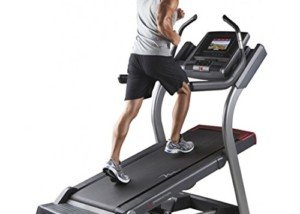Do your wrists always hurt during or after using a treadmill?
There’s a specific cause for this and a very simple solution, whether you use an incline, jog, briskly walk or slowly walk.
If your wrists begin hurting soon after you begin walking on a treadmill, or start aching shortly after – and you know this is because of your treadmill session – there’s an obvious reason why this happens.
And it is this: You’re holding onto the machine.
Yes, that’s the reason. Think about it: You may be tugging hard or clamping tightly on the portion of the machine that your hands usually make contact with.
- Is it the bar in front?
- Is it the side rails?
- Is it the “handles” that are above the bar where the heartrate sensors are?
- Is it on top of the console?
Any of these locations can cause strain to your wrists while you’re walking – or even jogging along.
How to Prevent Wrist Pain when Using a Treadmill
The prevention is NOT – I repeat – NOT to loosen your grip on the machine.
Rather, it’s to LET GO ENTIRELY. Yes, let go.
Holding onto something, let alone with a tight grip, is a totally unnatural way to walk, jog or run.
Do not confuse this with “holding onto” the handle of a stroller or Baby Jogger while walking or jogging outdoors.
When holding onto any type of stroller, you are pushing the device forward as you walk or jog, rather than holding onto it for support or balance.
But when you hold onto a treadmill, this is done for external support or balance – which I’ve found, after speaking to countless men and women about this – is only an imagined need.
Sure, you may feel that if you keep your hands off the treadmill, you’ll lose balance or won’t be able to keep up with the tread.
But the solution to this problem is as simple as 2 + 2: slow the speed and/or lower the incline.
There’s no such thing as an able-bodied person who can’t walk on a very slowly moving tread.
With my past work as a personal trainer, I clearly saw many people believing they needed to walk very slowly to get their bodies used to walking without holding onto the equipment.
However, in NO TIME, they were able to increase the speed and get up to the speed that they were using while holding on.
In fact, a common scenario was that I’d instruct them to let go without having them slow down the speed, if they weren’t using an incline.
Not one of these individuals ever toppled off the tread. Not one lost their balance. They simply continued on walking – with a visibly improved gait.
For those who were using a high incline, I’d have them slow way down or lower the incline.
Again, none ever fell off, and all reported that walking hands-free felt like more realistic exercise that was engaging their core more.
Walking hands-free will mean eliminating the strain, and therefor the pain or aching, in your wrists.
I also want to add that holding onto the treadmill — even if you never get sore wrists from this — is very sabotaging. VERY.
 Lorra Garrick is a former personal trainer certified by the American Council on Exercise. At Bally Total Fitness she trained clients of all ages for fat loss, muscle building, fitness and improved health.
Lorra Garrick is a former personal trainer certified by the American Council on Exercise. At Bally Total Fitness she trained clients of all ages for fat loss, muscle building, fitness and improved health.
.










































